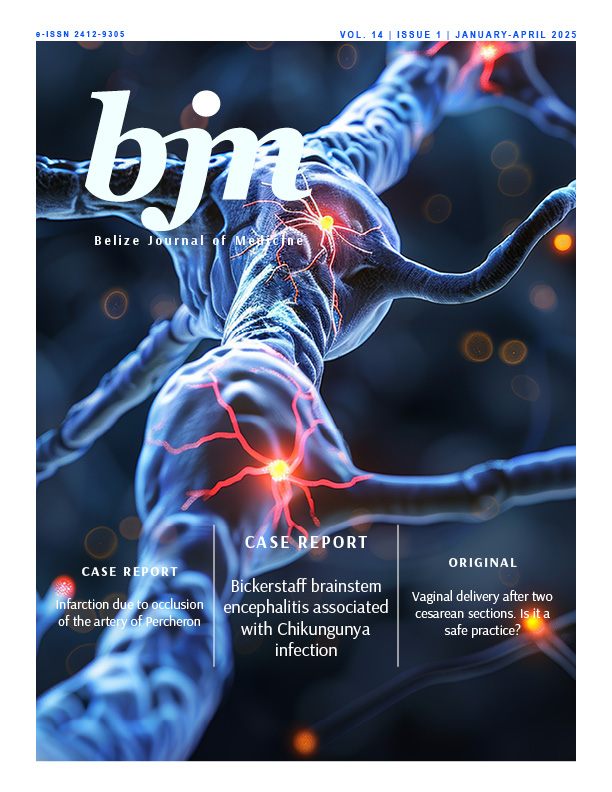Vaginal delivery after two cesarean sections. Is it a safe practice?
DOI:
https://doi.org/10.61997/bjm.v14i1.448Keywords:
c-section, Delivery, Uterine rupture, Obstetric complicationsAbstract
Introducción: Una creencia muy extendida es que una madre que ha tenido una cesárea ya no podrá tener un parto vaginal; sin embargo, hay evidencias de que es posible incluso con dos o más cesáreas anteriores. Objetivo: Describir los resultados del parto vaginal después de una y dos cesáreas previas en un hospital de atención secundaria de Djibouti. Métodos: Se realizó un estudio descriptivo, longitudinal, donde se incluyeron las pacientes con una o dos cesáreas anteriores de más de dos años, en trabajo de parto, sin condición que contraindique el parto transpelviano. Resultados: Todas las pacientes con dos cesáreas previas, y el 96,9 % de aquellas con una cesárea previa, se recibieron con más de 4cm de dilatación cervical. Al aplicar el puntaje de Flamm, 18 de las 33 pacientes con una cesárea previa, tenían alta probabilidad de éxito si se proseguía con el parto vaginal. El éxito global con una cesárea previa fue del 78,8 %, y del 87,5 % con el antecedente de dos cesáreas. Se presentaron 8 complicaciones, y 7 de ella correspondieron a pacientes con una sola cesárea previa. La complicación más frecuente fue la hemorragia postparto inmediato. Conclusiones: La frecuencia de parto vaginal exitoso después de una o dos cesáreas fue alta. La predicción fue más precisa para el grupo con dos cesáreas previas, aunque en ambos, cuando el puntaje de Flamm fue elevado, el parto vaginal casi siempre fue posible.
Downloads
References
Carroll CS Sr, Magann EF, Chauhan SP, Klauser CK, Morrison JC. Vaginal birth after cesarean section versus elective repeat cesarean delivery: weight-based outcomes. Am J Obstet Gynecol. 2003; 188:1516-20; discussion 1520-2. doi: 10.1067/mob.2003.472 DOI: https://doi.org/10.1067/mob.2003.472
Committee on Practice Bulletins-Obstetrics, Society for Maternal-Fetal Medicine. Practice Bulletin No. 169: Multifetal Gestations: Twin, Triplet, and Higher-Order Multifetal Pregnancies. Obstet Gynecol. 2016; 128:e131. Reaffirmed 2019. doi: 10.1097/aog.0000000000001709 DOI: https://doi.org/10.1097/AOG.0000000000001709
Eden KB, Denman MA, Emeis CL, McDonagh MS, Fu R, Janik RK, et al. Trial of labor and vaginal delivery rates in women with a prior cesarean. J Obstet Gynecol Neonatal Nurs. 2012; 41: 583-98. doi: 10.1111/j.1552-6909.2012.01388.x DOI: https://doi.org/10.1111/j.1552-6909.2012.01388.x
Flamm BL, Geiger AM. Vaginal birth after cesarean delivery: an admission scoring system. Obstet Gynecol. 1997; 90(6):907-10. doi: 10.1016/s0029-7844(97)00531-0 DOI: https://doi.org/10.1016/S0029-7844(97)00531-0
Cahill AG, Tuuli M, Odibo AO, Stamilio DM, Macones GA. Vaginal birth after caesarean for women with three or more prior caesareans: assessing safety and success. BJOG. 2010; 117(4):422-7. doi: 10.1111/j.1471-0528.2010.02498.x DOI: https://doi.org/10.1111/j.1471-0528.2010.02498.x
Arusi TT, Zewdu Assefa D, Gutulo MG, Gensa Geta T. Predictors of Uterine Rupture After One Previous Cesarean Section: An Unmatched Case-Control Study. Int J Womens Health. 2023; 15:1491-1500. doi: 10.2147/IJWH DOI: https://doi.org/10.2147/IJWH.S427749
Fruscalzo A, Rossetti E, Londero AP. Trial of Labor after Three or More Previous Cesarean Sections: Systematic Review and Meta-Analysis of Observational Studies. Z Geburtshilfe Neonatol. 2023; 227(2):96-105. doi: 10.1055/a-1965-4125 DOI: https://doi.org/10.1055/a-1965-4125
Flis W, Socha MW, Wartęga M, Cudnik R. Unexpected Uterine Rupture-A Case Report, Review of the Literature and Clinical Suggestions. J Clin Med. 2023; 12(10):3532. doi: 10.3390/jcm12103532 DOI: https://doi.org/10.3390/jcm12103532
Macones GA, Peipert J, Nelson DB, Odibo A, Stevens EJ, Stamilio DM, et al. Maternal complications with vaginal birth after cesarean delivery: a multicenter study. Am J Obstet Gynecol. 2005; 193(5):1656-62. doi: 10.1016/j.ajog.2005.04.002 DOI: https://doi.org/10.1016/j.ajog.2005.04.002
Horgan R, Hossain S, Fulginiti A, Patras A, Massaro R, Abuhamad AZ, et al. Trial of labor after two cesarean sections: A retrospective case-control study. J Obstet Gynaecol Res. 2022; 48(10):2528-33. doi: 10.1111/jog.15351 DOI: https://doi.org/10.1111/jog.15351
Charitou A, Charos D, Vamenou I, Vivilaki VG. Maternal and neonatal outcomes for women giving birth after previous cesarean. Eur J Midwifery. 2019; 3:8. doi: 10.18332/ejm/108297 DOI: https://doi.org/10.18332/ejm/108297
Wu Y, Kataria Y, Wang Z, Ming WK, Ellervik C. Factors associated with successful vaginal birth after a cesarean section: a systematic review and meta-analysis. BMC Pregnancy Childbirth. 2019 Oct; 19(1):360. doi: 10.1186/s12884-019-2517-y DOI: https://doi.org/10.1186/s12884-019-2517-y
Denham SH, Humphrey T, deLabrusse C, Dougall N. Mode of birth after caesarean section: individual prediction scores using Scottish population data. BMC Pregnancy Childbirth. 2019; 19(1):84. doi: 10.1186/s12884-019-2226-6 DOI: https://doi.org/10.1186/s12884-019-2226-6
Larsson C, Djuvfelt E, Lindam A, Tunón K, Nordin P. Surgical complications after caesarean section: A population-based cohort study. PLoS One. 2021; 16(10):e0258222. doi: 10.1371/journal.pone.0258222 DOI: https://doi.org/10.1371/journal.pone.0258222
Familiari A, Neri C, Caruso A, Airoldi C, Barone-Adesi F, Zanconato G, Bolomini G, Presti F. Vaginal birth after caesarean section: a multicentre study on prognostic factors and feasibility. Arch Gynecol Obstet. 2020; 301(2):509-15. doi: 10.1007/s00404-020-05454-0 DOI: https://doi.org/10.1007/s00404-020-05454-0
Girma Y, Menlkalew Z, Destaw A. Vaginal delivery after caesarean section and its associated factors in Mizan Tepi University Teaching Hospital, Southwest Ethiopia. Heliyon. 2021; 7(11):e08276. doi: 10.1016/j.heliyon.2021.e08276 DOI: https://doi.org/10.1016/j.heliyon.2021.e08276
Shehu CE, Chapa AM, Mbakwe MN, Panti AA. Vaginal birth after caesarean section (VBAC): a 5-year review. Eur J Pharm Med Res. 2019; 6(8):59-64. Disponible en: https://www.ejpmr.com/home/abstract_id/5436
Nisa, M. Hassan, L. Trend of vaginal delivery after one previous caesarean section in a tertiary care hospital. Pakistan J. Med. Res. 2004; 43.
Tsai HT, Wu CH. Vaginal birth after cesarean section-The world trend and local experience in Taiwan. Taiwan J Obstet Gynecol. 2017; 56(1):41-5. doi: 10.1016/j.tjog.2016.03.007 DOI: https://doi.org/10.1016/j.tjog.2016.03.007
De Leo R, La Gamba DA, Manzoni P, De Lorenzi R, Torresan S, Franchi M, et al. Vaginal Birth after Two Previous Cesarean Sections versus Elective Repeated Cesarean: A Retrospective Study. Am J Perinatol. 2020; 37(S 02):S84-S88. doi: 10.1055/s-0040-1714344 DOI: https://doi.org/10.1055/s-0040-1714344
Sahin S, Ozkaya E, Eroglu M, Sanverdi I, Celik Z, Cakıroglu A. Predictors of successful vaginal birth after a caesarean in women with a previous single caesarean delivery. Eur Rev Med Pharmacol Sci. 2022; 26(5):1594-600. doi: 10.26355/eurrev_202203_28226
Li YX, Bai Z, Long DJ, Wang HB, Wu YF, Reilly KH, et al. Predicting the success of vaginal birth after caesarean delivery: a retrospective cohort study in China. BMJ Open. 2019; 9(5):e027807. doi: 10.1136/bmjopen-2018-027807 DOI: https://doi.org/10.1136/bmjopen-2018-027807
Bălălău OD, Bacalbașa N, Olaru OG, Pleș L, Stănescu DA. Vaginal birth after cesarean section – literature review and modern guidelines. J Clin Invest Surg. 2020; 5(1): 13-17. doi: 10.25083/2559.5555/5.1/13.17 DOI: https://doi.org/10.25083/2559.5555/5.1/13.17
Lin J, Hou Y, Ke Y, Zeng W, Gu W. Establishment and validation of a prediction model for vaginal delivery after cesarean and its pregnancy outcomes-Based on a prospective study. Eur J Obstet Gynecol Reprod Biol. 2019; 242:114-21. doi: 10.1016/j.ejogrb.2019.09.015 DOI: https://doi.org/10.1016/j.ejogrb.2019.09.015
Davis D, S Homer C, Clack D, Turkmani S, Foureur M. Choosing vaginal birth after caesarean section: Motivating factors. Midwifery. 2020; 88:102766. doi: 10.1016/j.midw.2020.102766 DOI: https://doi.org/10.1016/j.midw.2020.102766
Firoozi M, Tara F, Ahanchian MR, Latifnejad Roudsari R. Health Care System Barriers to Vaginal Birth after Cesarean Section: A Qualitative Study. Iran J Nurs Midwifery Res. 2020; 25(3):202-11. doi: 10.4103/ijnmr.IJNMR_150_19 DOI: https://doi.org/10.4103/ijnmr.IJNMR_150_19
Downloads
Published
How to Cite
Issue
Section
License
Copyright (c) 2025 Deivys Rodríguez Navarro, Saraima Kendra Guerra Calvo

This work is licensed under a Creative Commons Attribution-NonCommercial 4.0 International License.
BJM protects Copyright at all times. However, it gives up part of the rights by displaying a Creative Commons License 4.0 (cc-by-nc), which allows the use of the work to share (copy and redistribute the material in any support or format) and adapt (transform and built from the material) as long as exclusive mention of the publication in the journal as the primary source is made. Under no circumstances, the work can be commercialized.













